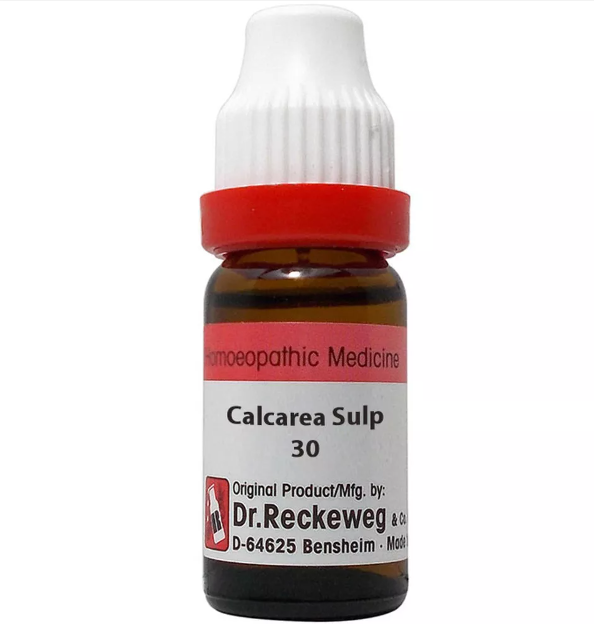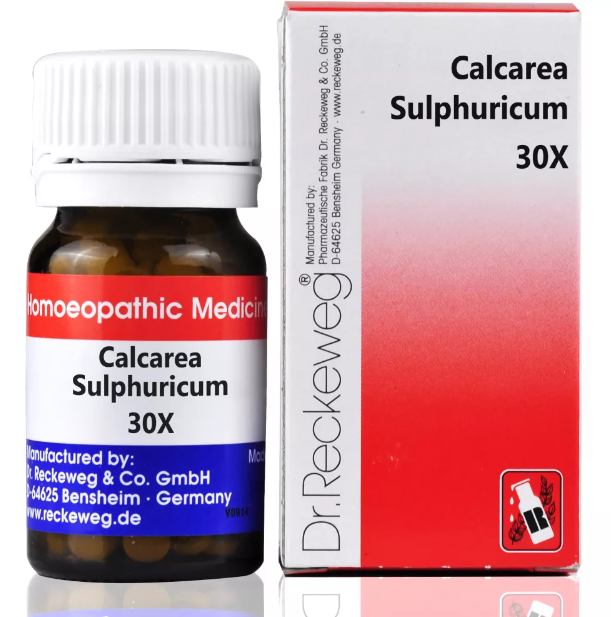CALCAREA SULPHURICA 3x, 6x, 12x, 30x, 200x, 6C, 12C, 30C, 200C, 1M, 10M USES AND SYMPTOMS
 CALCAREA SULPHURICA (Sulphate of Lime, Plaster of Paris)
CALCAREA SULPHURICA (Sulphate of Lime, Plaster of Paris)
Treats eczema, torpid glandular swellings, cystic tumors, and fibroids. Effective for suppurative processes after pus has vented. Mucus discharges are yellow, thick, and lumpy. Used for lupus vulgaris.
Head: Scald head in children with purulent discharge or yellow, purulent crusts.
Eyes: Eye inflammation with thick, yellow discharge. Sees only half an object. Cornea smoky. Used for ophthalmia neonatorum.
Ears: Deafness with discharge from the middle ear, sometimes mixed with blood. Pimples around the ear.
Nose: Cold with thick, yellowish, purulent secretion, sometimes blood-tinged. One-sided nasal discharge. Yellow discharge from posterior nares. Sore nostril edges.
Face: Pimples and pustules. Herpes.
Mouth: Sore lips. Flabby tongue like dried clay. Sour, soapy, acrid taste. Yellow coating at the base.
Throat: Last stage of ulcerated sore throat with yellow discharge. Suppurating tonsillitis when abscess is discharging.
Abdomen: Liver region pain on the right side of the pelvis, followed by weakness, nausea, and stomach pain.
Stool: Purulent diarrhea mixed with blood. Diarrhea after maple sugar or weather changes. Pus-like slimy bowel discharge. Painful abscesses around the anus in fistula cases.
Female: Late, long-lasting menses with headache, twitching, and great weakness.
Respiratory: Cough with purulent, sanious sputum and hectic fever. Empyema with pus in the lungs or pleural cavities. Catarrh with thick, lumpy, whitish-yellow, or pus-like secretion.
Extremities: Burning and itching in the soles.
Fever: Hectic fever with pus formation, cough, and burning soles.
Skin: Cuts, wounds, and bruises discharge pus and heal slowly. Yellow, purulent crusts or discharges. Purulent exudations on the skin. Yellowish scabs. Numerous small pimples under the hair, bleeding when scratched. Dry eczema in children.
Relationship: Compare with Hep., Sil.
Dose: Second and third trituration. Twelfth potency effective for lupus.
SYMPTOMS OF CALCAREA SULPHURICA
Head:
Scald head in children with purulent discharge or yellow, purulent crusts.
Eyes:
Eye inflammation with thick, yellow discharge.
Seeing only half of an object (hemiopia).
Smoky cornea.
Ophthalmia neonatorum.
Ears:
Deafness with discharge of matter from the middle ear, sometimes mixed with blood.
Pimples around the ear.
Nose:
Colds in the head with thick, yellowish, purulent secretions, often tinged with blood.
One-sided discharge from the nose.
Yellowish discharge from the posterior nares.
Sore edges of nostrils.
Face:
Pimples, pustules, and herpes outbreaks.
Mouth:
Soreness inside lips.
Flabby tongue resembling dried clay.
Sour, soapy, acrid taste.
Yellow coating at the base of the tongue.
Throat:
Last stage of ulcerated sore throats with yellow discharge.
Suppurating stage of tonsillitis with discharging abscess.
Abdomen:
Pain in the liver region on the right side of the pelvis, followed by weakness, nausea, and stomach pain.
Stool:
Purulent diarrhea mixed with blood (dysentery).
Diarrhea after consuming maple sugar or due to changes in weather.
Pus-like slimy discharge from the bowels.
Painful abscesses around the anus in cases of fistula.
Female:
Late, long-lasting menses with headache, twitching, and great weakness.
Respiratory:
Cough with purulent, sanious sputum and hectic fever.
Empyema, pus formation in the lungs or pleural cavities.
Thick, lumpy, whitish-yellow, or pus-like secretion in catarrh (pneumonia – third stage, emphysema).
Extremities:
Burning and itching in the soles of the feet.
Fever:
Hectic fever caused by the formation of pus, often with cough and burning in the soles of the feet.
Skin:
Cuts, wounds, bruises, etc., that are unhealthy and discharging pus, with slow healing.
Yellow, purulent crusts or discharges.
Skin affections with yellowish scabs.
Dry eczema in children.
selection of the potency
Individualization:
- Homeopathy is based on the principle of treating the individual, not just the disease. The unique symptoms and characteristics of the person are crucial in determining the most suitable potency.
Intensity of Symptoms:
- The intensity of the symptoms guides the choice of potency. If the symptoms are intense and acute, a lower potency (e.g., 6C, 30C) might be considered. For chronic conditions with less intensity, higher potencies (e.g., 200C, 1M) may be appropriate.
Sensitivity of the Patient:
- Some individuals are more sensitive to homeopathic remedies, while others may require higher potencies. The practitioner considers the patient’s sensitivity when selecting the potency.
Acute vs. Chronic Conditions:
- Lower potencies are often used for acute conditions, while higher potencies may be considered for chronic or long-standing issues.
Previous Response to Potencies:
- The patient’s response to previous homeopathic treatments helps guide the choice of potency. If a particular potency has been effective in the past, it may be repeated or adjusted as needed.
Vital Force and Susceptibility:
- Homeopathy views illness as a disturbance in the vital force. The practitioner assesses the patient’s overall vitality and susceptibility to determine the appropriate potency.
Aggravation or Amelioration:
- The direction of the symptom response (aggravation or amelioration) after taking a remedy can influence the choice of potency.
Miasmatic Considerations:
- In classical homeopathy, the concept of miasms (inherited disease tendencies) is considered. The practitioner take this into account when selecting the potency.
Practitioner Experience:
- The experience and preference of the homeopathic practitioner play a role. Some practitioners may have success with certain potencies based on their clinical experience.
SAFETY INFORMATION
- Do not exceed the recommended dose by physician
- Keep out of the reach of children
- Store in a cool dry place away from direct sunlight
- Maintain half an hour gap between food/drink/any other medicines and homoeopathic medicine
- Avoid any strong smell in the mouth while taking medicine e.g. camphor, garlic, onion, coffee, hing
Medicine images use for reference only selection of homeopathic medicine depends on the individual’s specific symptoms and overall constitution. Moreover, homeopathy is a holistic system of medicine that treats the individual as a whole. In addition to addressing the physical symptoms, it takes into account the emotional and mental state of the person. Consequently, it’s crucial to consult with a qualified homeopathic practitioner for personalized treatment.
The information provided on this website is intended solely for educational purposes. Always seek the advice of your physician or other qualified health provider.
